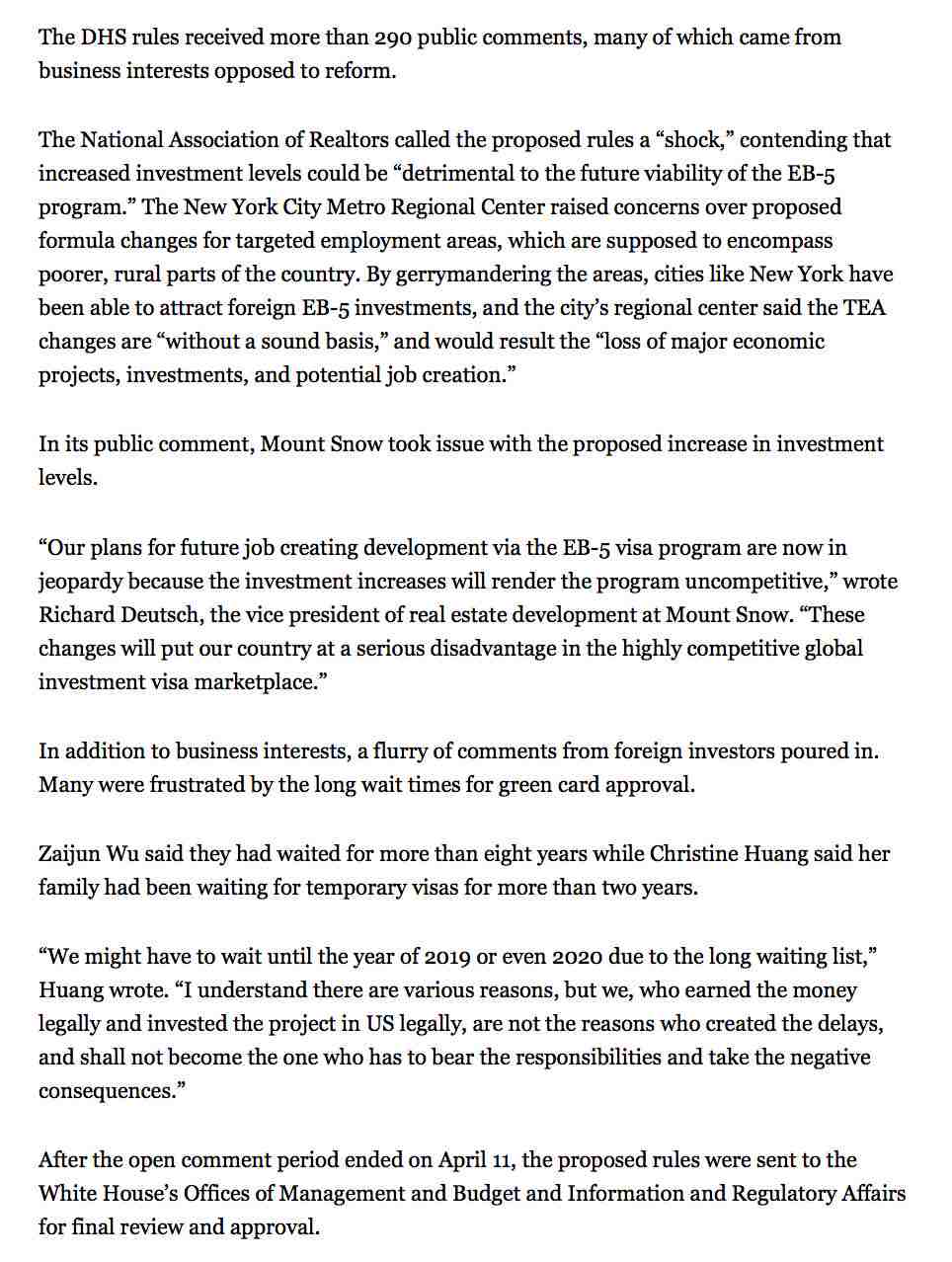移民局再投资新政,发表评议的最后一天|行动指南

欢迎订阅微信公众号“美国EB5一点通”(USA-EB-5),中立深度及时,让EB5Sir与您分享EB-5中文第一手资讯。如需转载,请回复“
版权声明”查阅。
6月14日,移民局发布了新的审案备忘录,关于就业创造和投资维持的审案政策(参考阅读:新备忘录出炉:就业创造和投资维持|EB-5重磅)。新政有喜有忧,关于就业维持的认定是利好,关于I-829递交之后无需维持就业是利好,但是关于再投资和区域中心关停之后对于EB-5投资者移民身份的影响,不是特别有利(参考阅读:利好、遗憾与行动指南|移民局新政解读)。
按照移民局的要求,在6月28日之前,外界都可以向其提出自己的意见和建议。
提出意见方式:
Please send all comments to [email protected] and be sure to include the following to make your comments clear:
▪ State the title of the relevant volume and section in the subject line of your message;
▪ Refer to a specific portion of the document;
▪ Explain the reason for any recommended change; and
▪ Include data, information, or authority that supports the recommendation.
Opening & Closing Dates for Comments: June 14, 2017 – June 28, 2017
简单翻译下,把意见发邮件到:[email protected],邮件的格式规范为:
1. 在邮件标题注明,相关的volume和section(卷和章节);
2. 注明文件具体的段落;
3. 解释任何改变的原因;以及
4. 包括支持你建议的数据、信息或相关文件;
有投资者期望,EB5Sir能呼吁下,EB-5投资者能够发出自己的声音。
本来想等到行业协会,IIUSA公布了他们给移民局的反馈意见之后,再将他们意见文本供各位参考。但是,他们也是要拖到最后一天才整理完毕业内各方意见。
所以,今天就个人不太成熟的理解,就着三脚猫英文,大体提了三个意见:
1. 对于再投资,按照业内几个律师的观点,在移民法中并未要求,在创造过就业之后,还要继续维持投资;
2. 即便继续维持再投资,最新的这个政策备忘录,不清不楚,容易被利用,损害投资者利益;
3. 区域中心关停,将会使得因为排期还没有获得临时绿卡的中国投资者I-526获批被收回,而其他没有排期国家的投资者因为可以马上登陆而不受影响,甚至最后获得永久绿卡,机制不公平;
邮件文本如下:
Sub: Comments over USCIS Policy Manual - Volume 6 (Immigrants), Part G: Investors
On June 14, 2017, USCIS published revisions to the USCIS Policy Manual, as to Job Creation and Capital At Risk Requirements for Adjudication of Form I-526 and Form I-829.
We are glad to see USCIS is moving further to enhance the integrity of EB-5 program. While some part of this new policy may make big troubles to investors and hurt EB-5 program as well.
I. Redeployment of Funds after Job Created is not reasonable
The new policy requires investors to sustain the investment “throughout the period of his or her status as a conditional permanent resident of the United States”.
As some lawyers indicated, nothing in the statute, regulations or precedent decisions requires the capital to be at risk after job creation. And it was not the original intention of Congress to keep the investment so long as far as the visa backlog concern.
Take considering of visa backlog issue, EB-5 money will be redeoplyed several times without the involvement of EB-5 investors for 5+ years after I-526 approved and job created, regional centers or developers will have chance to put EB-5 money into high risk projects, while EB-5 investors usually can do nothing. Then we are expected to see that EB-5 investors and EB-5 program will be hurt finally or endless law suits will be raised by investors in coming years.
2. The language is not clear enough for practice
In the current offering documents of EB-5 projects, there are no clear terms as to the redeployment. Will it leave only to regional centers to make decision without involvement of EB-5 investors, or will it leave to you to make decision case by case what is a right redeployment without being considered as material changes to hurt EB-5 investors immigration status?
From the language of current policy manual, I can’t see clearly how to do redeployment to avoid the material changes, especially for these current running projects.
3. Termination of Regional Center will treat investors differently and hurt innocent ones
In your new policy: Termination of a regional center before an investor's admission as a conditional resident constitutes a material change requiring denial or revocation of the I-526, but for an investor who already obtained conditional residence it does not have an effect on I-829, even for claiming indirect job creation.
I have no idea how you define material change. As you know, the vise backlog issue is pretty serious to China mainland born investors. In same project happened to be closed due to regional center’s fraud or the owners just want to close the RC, some investors from other countries are safe due to they are already in CPR status, while other innocent Chinese investors’ I-526 approval will be revoked after long years waiting for visa availability even the required jobs created. Is it a fair play game designed by Congress in their original intentions, to treat investors differently? I doubt it.
I’d like to request you review your policy and see if you can improve the integrity of EB-5 program further and treat EB-5 investors more favorably.
Thanks and Regards,
***
Shanghai, China
Referred articles from attorneys:
1. http://www.klaskolaw.com/eb-5-investor-visas/uscis-policy-manual-changes-on-sustainment-at-risk-redeployment-and-regional-center-terminations-good-bad-and-ugly/
2. http://mshahlaw.com/redeployment-version-2-0-serious-issues-uscis-new-policy-manual-changes/
3. https://iiusa.org/blog/wp-content/uploads/2017/06/USCIS-Finalizes-EB-5-Sustainment-and-RC-Termination-Changes.pdf
如果,有兴趣的话,各位EB-5投资者们,可以提出自己的意见。可以参考EB5Sir的文本,也可以参考上面3个律师各自的意见链接,还可以参考下W同学写的一个意见书:
To whom it may concern,
We are pleased and grateful to review your recent update regarding EB-5 policy manual guidelines on sustaining investment and redeployment. We appreciate your effort in protecting investors and ensuring the efficiency of the EB-5 program. However, as investors, we believe that parts of your new policy manual may be unnecessary, and it would be better to provide revision or clarification.
We first and foremost believe that “redeployment” is unnecessary in nature and should not exist at the first place. Current policy manual requires investors to sustain the investment “throughout the period of his or her status as a conditional permanent resident of the United States” (Chapter 5A). However, due to the current visa backlog, investors from China may face a multi-year waitlist before being admitted to the United States. As a result, a Chinese investor may be asked to redeploy their investments to other entities or projects, as his or her permanent residency status may not have begun at the time when investments are returned. We believe that such policy is unfair in nature, due to the following reasons:
1. It significantly amplifies the risk of investment for certain groups of investors simply because of their national origin. If an investor has already sustained an investment for a reasonable amount of time and has already created 10 jobs in accordance to current EB-5 law, then such investor should not be asked to endure more risks beyond his or her duty.
2. A Chinese investor may have to redeploy his or her money multiple times to multiple entities to sustain the EB-5 eligibility. This deviates from the congressional intent of EB-5 program, which was meant only to ask investors to invest in one entity to create 10 jobs. Congress did not design the EB-5 program to ask investors to sustain their investments in many projects and to endure multi-level risks from multiple projects.
3. As EB-5 visa backlog can be unpredictable, investors who need to wait for decades for a visa may see the program as extremely unattractive, as they will never receive their investments in any foreseeable future.
4. Not all developers or regional centers have sufficient resources to accommodate investors to redeploy their investments. It may particularly create chaos in small regional centers and developers.
5. Redeployment may involve significant extension or revision of contracts between investors and regional centers, entities, and enterprises. This may cause unnecessary chaos as many contracts have been made without an expectation from any participant that future redeployment is necessary.
Therefore, in the spirit of congressional intent, we respectfully request that investors be allowed to withdraw their investments and not be subjected to redeployment beyond the reasonable timeframe, if and only if investments have been used properly for at least two years and 10 jobs have been properly created.
Even if all investors are subjected to “sustaining investment” due to restrains from languages of immigration laws, many passages and definitions used in your policy manual are unclear, which may prevent good-faith investors from properly following your guidelines. Examples include:
A. Policy manual requires that redeployment must be “within a commercially reasonable time” (Chapter 2-A-2). What is “reasonable time”? Is one month reasonable? One year? One week? If there is a five-week gap before redeployment, does that constitute a reason to deny an investor’s I-829? If such requirement is evaluated based on intuitive understanding of an immigrantion officer, then there is no safe ground for any investor unless such investment is redeployed immediately with absolutely no gap.
B. Policy manual requires that “the capital is properly at risk if it is used in a manner related to engagement in commerce” (Chapter 2-A-2). What does “engagement in commerce” mean? If an investment was originally deployed in construction of a bridge, but now is redeployed to construction of an airport nearby, does that satisfy this requirement? It is unclear.
C. Policy manual requires that redeployment should be “consistent with the scope of the NCE’s ongoing business” (Chapter 2-A-2). What does “consistent” mean? Does such rule apply to direct investment? Does such rule apply to loan related investment?
D. For loan investment, policy manual requires that it is a “similar loan” (Chapter 2-A-2). What does “similar loan” mean? How similar?
E. Since “redeployment” significantly changes the timeline and the scope of investment, will USCIS require all current investors to amend their I-526s to comply with new redeployment requirements? Will current investors be grandfathered?
F. If an investor redeploys an investment and experience a complete loss, does such loss impact the investor’s immigration status?
Our concerns above demonstrate that part this policy manual is still unclear, and an unclear statement may lead to misunderstanding or ultimately denial of an innocent investor’s immigration status. In spirit of Congressional intent and the philosophy of fairness, we respectfully request that USCIS consider our concerns to reduce the financial risk of redeployment and its impact on immigration status. Investors should not be held for any extra responsibility beyond creating 10 jobs with a reasonable time of “at risk” investment. However, if current regulation requires us do endure extra responsibility, we request that you ensure the process is clear and efficient.
Sincerely,
XXX
为了避免,发送相同的内容致使移民局认为是垃圾邮件,各位投资者朋友,最好还是能够改改再发。
个人认为,投资者朋友们,有机会发声,还是要抓住机会,哪怕不能一触而就。今天,就看到一篇美国媒体的报道,关于EB-5改革的,就提到移民局对于EB-5改革的提案,外国投资者就提出了非常多的意见,其中例举了两位,应该就是中国投资者,截图如下:

有一定英文能力的投资者,可以行动起来,明天是6月28日,提交意见的最后截止日期。
最后,再提醒下邮件格式:
意见发邮件到:[email protected],邮件的格式规范为:
1. 在邮件标题注明,相关的volume和section(卷和章节);
2. 注明文件具体的段落;
3. 解释任何改变的原因;以及
4. 包括支持你建议的数据、信息或相关文件;
点击左下角“阅读原文”进入yitoulu.com就本文讨论;任何意见建议请进入公众号留言;欢迎点击右下角“写留言”评论互动。

最新评论
推荐文章
作者最新文章
你可能感兴趣的文章
Copyright Disclaimer: The copyright of contents (including texts, images, videos and audios) posted above belong to the User who shared or the third-party website which the User shared from. If you found your copyright have been infringed, please send a DMCA takedown notice to [email protected]. For more detail of the source, please click on the button "Read Original Post" below. For other communications, please send to [email protected].
版权声明:以上内容为用户推荐收藏至CareerEngine平台,其内容(含文字、图片、视频、音频等)及知识版权均属用户或用户转发自的第三方网站,如涉嫌侵权,请通知[email protected]进行信息删除。如需查看信息来源,请点击“查看原文”。如需洽谈其它事宜,请联系[email protected]。
版权声明:以上内容为用户推荐收藏至CareerEngine平台,其内容(含文字、图片、视频、音频等)及知识版权均属用户或用户转发自的第三方网站,如涉嫌侵权,请通知[email protected]进行信息删除。如需查看信息来源,请点击“查看原文”。如需洽谈其它事宜,请联系[email protected]。